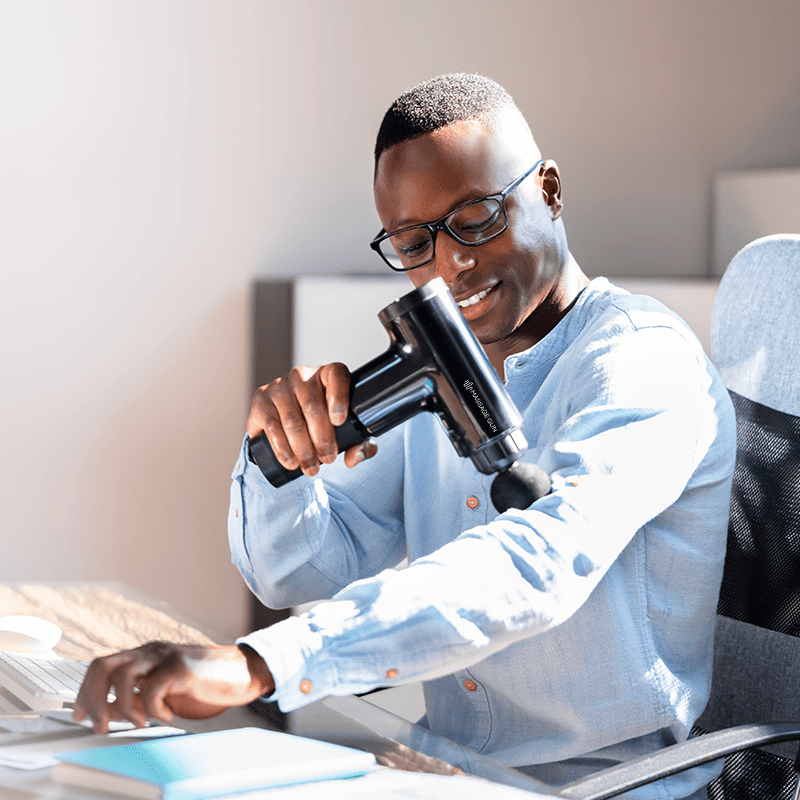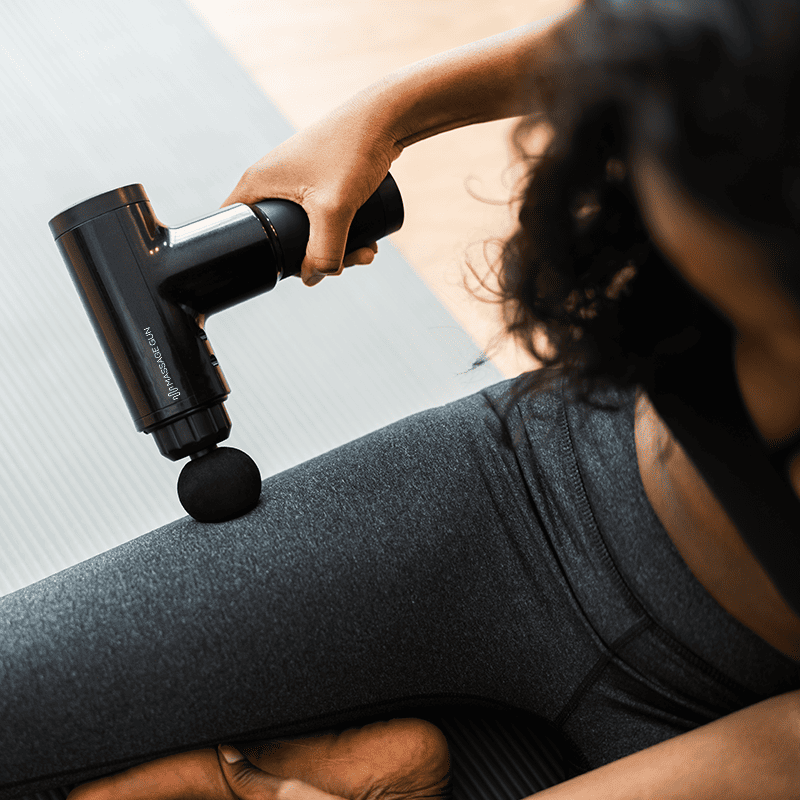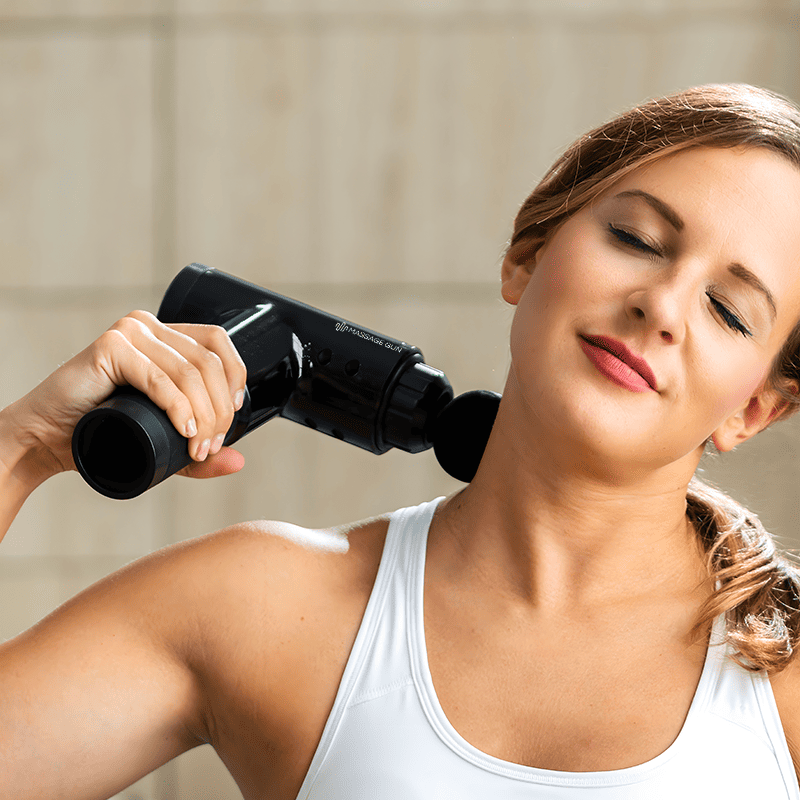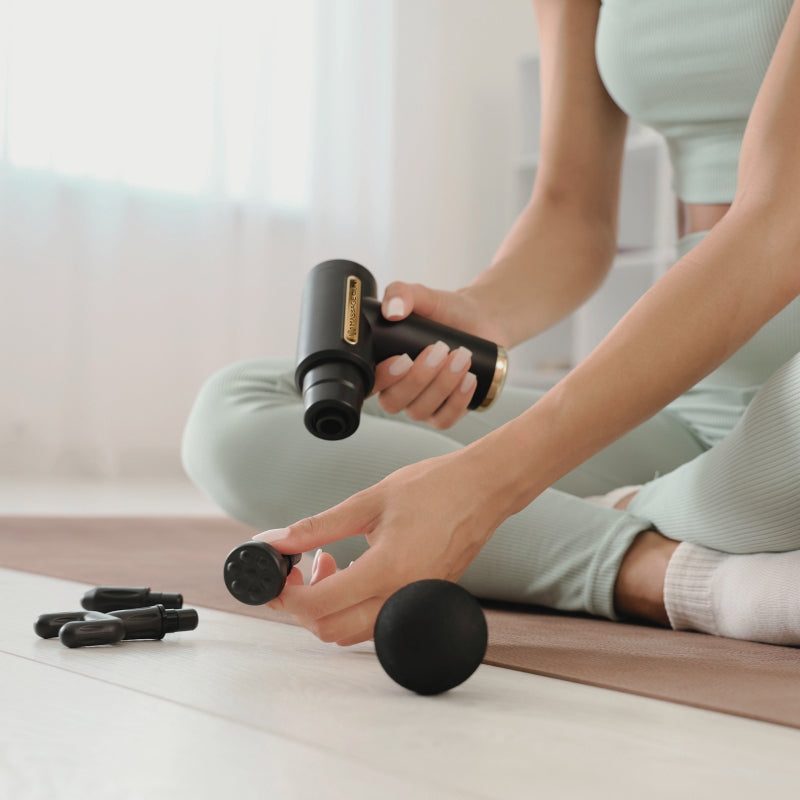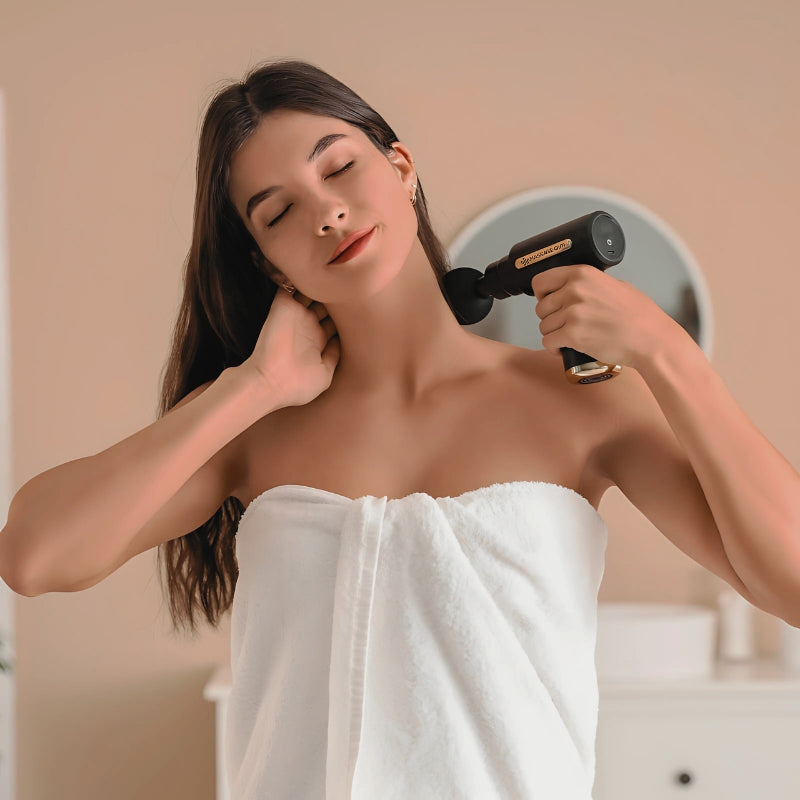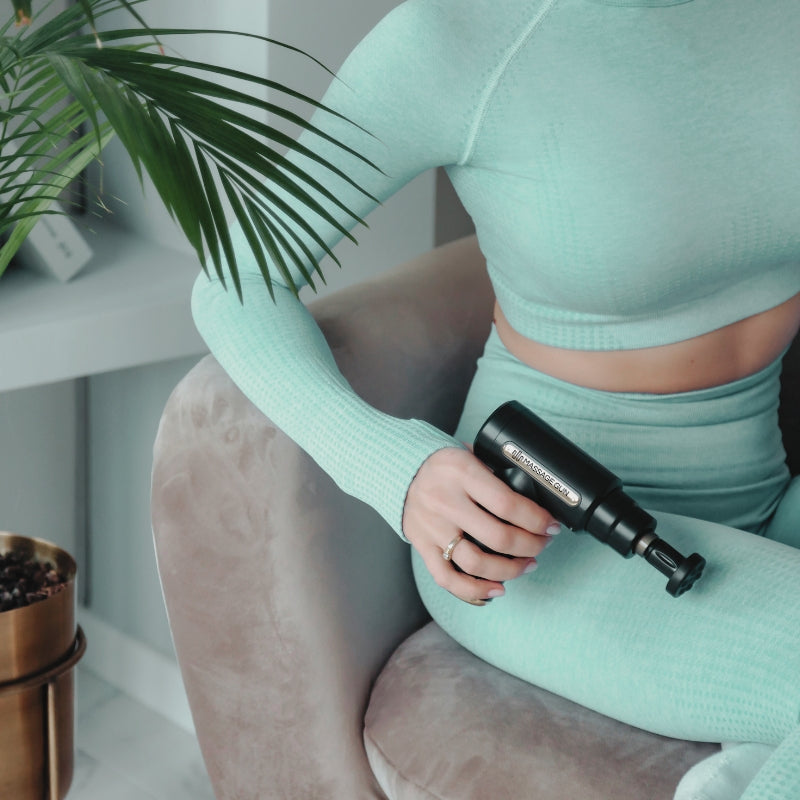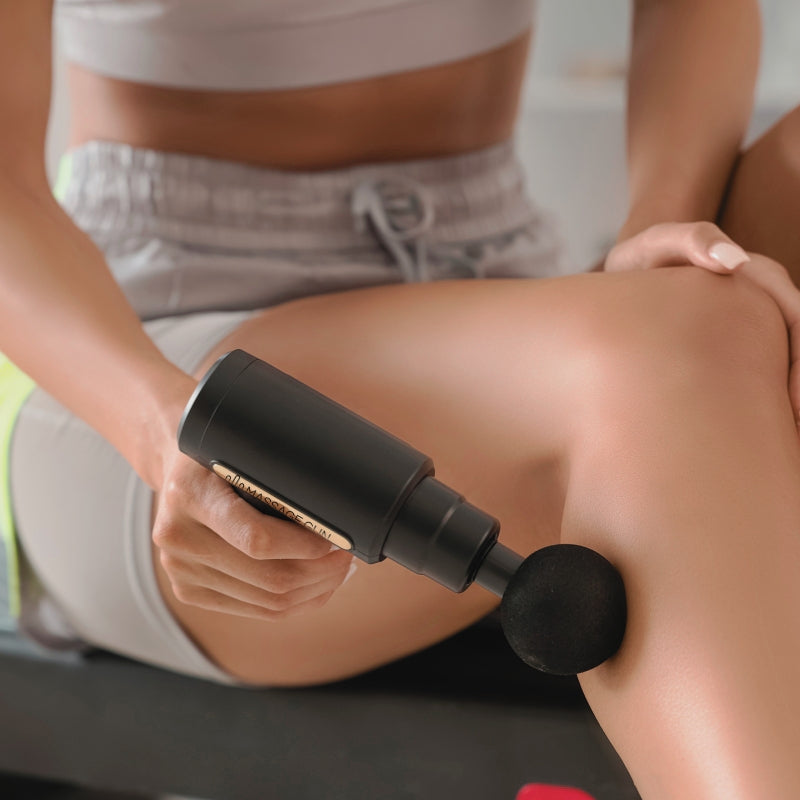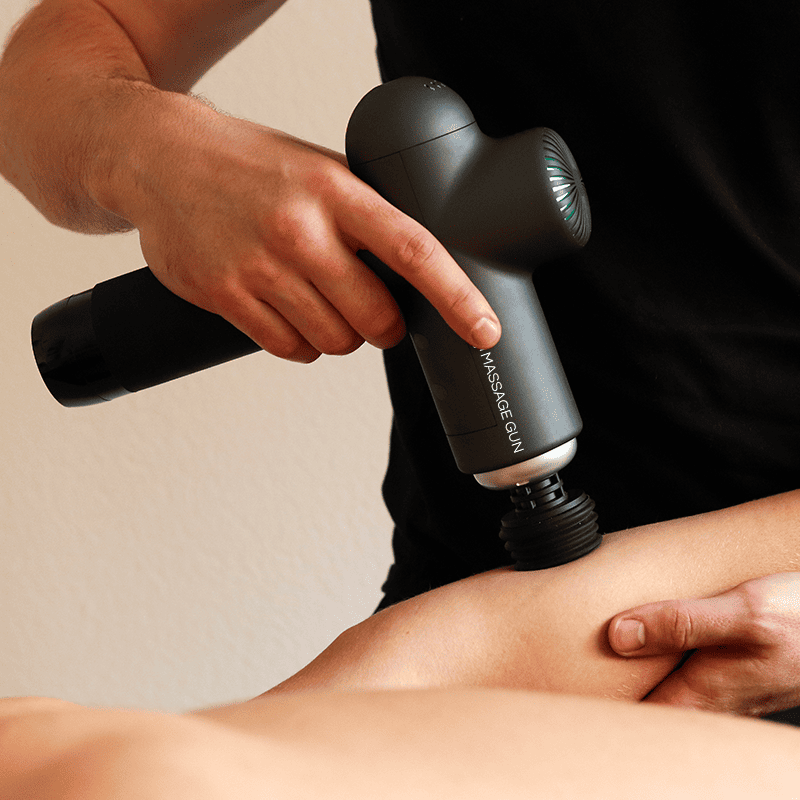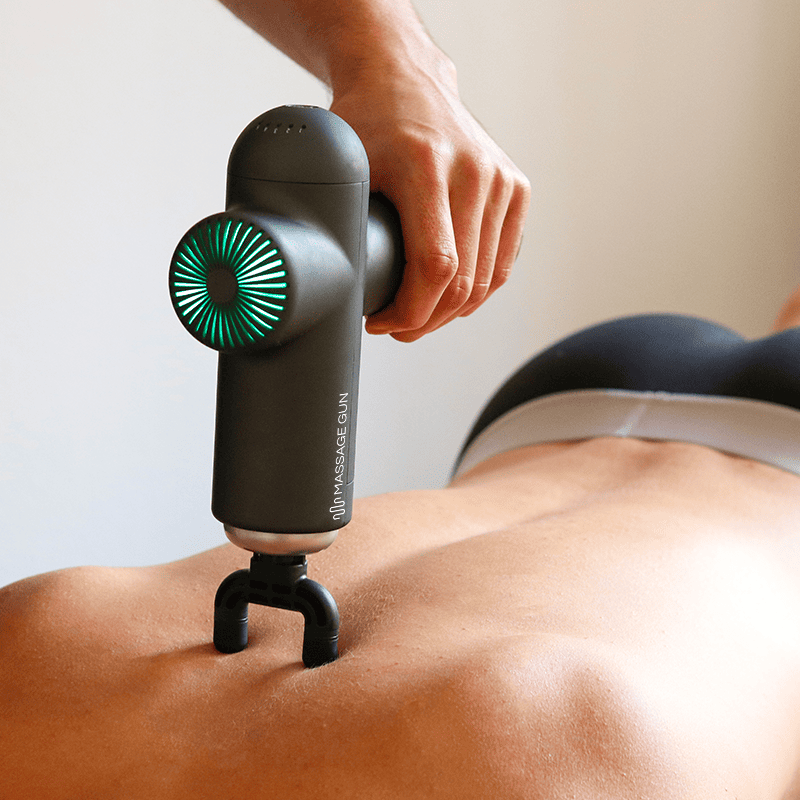What you need to know before you start?

What is a massage gun & how it works?
A massage gun is a handheld recovery tool that delivers rapid pulses of pressure into the muscle tissue. This percussive therapy, often called percussion massage or vibration massage, helps relieve muscle tension, improve mobility, and reduce inflammation.
Unlike traditional massage or foam rolling, this popular item offers a more targeted and deeper approach. It's ideal for athletes, fitness enthusiasts, or anyone dealing with muscle pain or discomfort. The repetitive tapping motion mimics a deep-tissue massage therapist's technique, making it a powerful tool for wellness and recovery.
Is it right for you? Who should (and shouldn't) use a massage gun?
Massage guns work for most people who experience muscular tightness, sore muscles, or chronic pain. Office workers, athletes, and people recovering from workouts often benefit the most.
However, individuals with conditions like nerve pain, bony areas, joint injuries, or vascular problems should avoid using a massage gun without consulting a physical therapist. A physical therapy or massage therapist can guide you through a proper assessment. Also, pregnant individuals should seek medical advice before incorporating this type of massage therapy into their routine.
Anatomy of a massage gun: heads, speed, and force
Massage guns come with interchangeable massage heads designed to target specific muscle groups. Flat heads are great for general use, bullet heads target knots and deep tissues, and fork heads are suited for the spine and neck area to avoid bony protrusions.
Soft heads are beneficial when dealing with sensitive or sore areas. Speed settings range from gentle pulses to intense percussive massage treatment. Start with low settings and gradually increase the intensity. Stall force and amplitude determine how deep the tool penetrates, while circular motion can help improve blood flow.
The right way to use a massage gun (core techniques)

General best practices (the "do's")
Always turn on the massage gun before placing it on your body. Move it slowly and steadily over the target muscle groups. Spend 1-2 minutes on each area, using proper technique to avoid extra pressure.
Focus on the belly of the muscle and avoid staying in one spot. This article recommends applying pressure gently at first, and then adjusting based on how the muscle responds. Massage guns can help relieve muscle tension and improve range of motion when used correctly.
What to absolutely avoid?
Avoid using a massage gun on injuries such as sprains, bruises, or recently injured joints. Do not apply pressure directly to bony areas or hold the massager in one place for too long. This can increase discomfort and even cause bruising.
Avoid using a massage gun every day without breaks, especially on sore or tight areas that haven’t had time to recover. Improper use may worsen pain and soreness. A physical therapist can teach you how to use this tool safely and effectively, especially for pain relief or myofascial release.
How to use it on key muscle groups?
When treating specific areas, use the correct massage head and technique. For your neck and shoulders, be careful and use soft or fork heads with low speed. On your quads and hamstrings, apply pressure gradually using a flat head. For the calf, use a bullet or round head to work out knots and tight spots.
Glide the gun slowly up and down for 1-2 minutes. Avoid the front of the neck, bones, or areas that feel sharp. Pairing the massage with light stretching can be beneficial for muscle recovery and improved mobility.
Advanced techniques most articles don’t talk about

Integrating breathwork with massage gun use
Breathwork during a massage gun session can help reduce stress and allow the body to relax more deeply. As you breathe deeply, the nervous system shifts to a calmer state, which enhances the effects of vibration massage.
Inhale slowly before applying the massage, and exhale as the gun passes over the muscle. This approach is often recommended by massage therapists and physical therapy professionals. When done properly, it helps relieve muscle tension and contributes to overall health and wellness.
Using massage guns for mental reset & focus
Massage guns are not just for physical treatment they can also aid mental clarity. By stimulating areas like the collarbone or traps while breathing deeply, you can activate the parasympathetic system and achieve a sense of calm. This method has been shown to help relieve stress and can be part of a daily wellness routine.
It's especially effective when used with ice or post-exercise stretching. Published in the journal of alternative and complementary medicine, a literature review supports the link between percussive therapy and mental relaxation.
Pre-workout activation vs post-workout recovery
Before a workout, use the massage gun to increase blood flow and activate key muscles. A workout massage should target the glutes, hamstrings, or shoulders for about 30 seconds per area. After training, shift to recovery mode by using the gun on sore muscles to help reduce delayed onset muscle soreness (DOMS).
This massage gun technique is especially beneficial when paired with ice and stretching. Always stay in motion and be mindful not to hold the gun still. Massage guns can help prevent muscle stiffness and enhance the effects of your exercise program.
When, how often, and for how long?

Timing matters: best times to use it in a day
Morning use can help reduce overnight stiffness, while evening sessions are ideal for post-workout or relaxation. After physical activity, a massage gun can help relieve pain and improve your range of motion.
During the workday, it can also reduce discomfort from poor posture or long hours at a desk. Many therapists recommend using it in short bursts as part of your wellness routine. Proper timing combined with proper technique makes the massage more effective and helps prevent overuse.
Frequency of use: daily or just occasionally?
While it may be tempting to use your massage gun every day, it's best to space sessions out depending on your body’s needs. If you are dealing with chronic pain or recovering from a hard workout, 10–15 minutes a day may be appropriate. Otherwise, 2–4 sessions per week are ideal.
Listen to your body and gradually increase the frequency if needed. If you feel any pain and soreness after a session, consider resting or consulting a therapist. Overuse can cause muscle irritation rather than pain relief.
What to look for when choosing your massage gun?

Features that actually matter (and which don't)
Look for massage guns with quiet motors, good battery life, and multiple head attachments. Tools with high amplitude and stall force are better for deeper tissues. Some advanced models feature vibration massage settings for myofascial release or pain relief.
Avoid paying extra for unnecessary tech features unless you need them. Choose a massager with an ergonomic handle so you can reach tricky spots like the mid-back. The right massage gun should match your specific needs and offer safe, effective treatment.
Price vs performance: how to choose smart
Massage guns range from budget to high-end models. Consider your goals: if you want a general recovery tool, an affordable option may suffice. For serious athletes or those undergoing physical therapy, premium models offer more power and longevity. Be careful not to overspend on features you won’t use.
A well-reviewed device with the right massage head attachments can make all the difference. Compare devices based on how effectively they apply pressure, reach sore areas, and prevent further injury.
Can I use a massage gun every day?
Yes, you can, but with caution. Limit use to 10–15 minutes per session and focus on 1–2 muscle groups to avoid overstimulation. Always monitor how your body feels and take rest days if you notice lingering soreness or discomfort. Rotate muscle groups daily to allow for proper recovery and avoid overuse injuries.
What if I'm already sore?
Using a massage gun on sore muscles can be helpful, but proceed gently. Choose a soft massage head and use a low speed to avoid increasing discomfort. Move slowly in a circular motion and spend no more than 1–2 minutes per area. This approach helps reduce inflammation and encourages muscle repair.
Can I use it on my jaw or face?
No, it's not recommended to use a massage gun on your jaw, face, or other bony areas. These regions are sensitive and have a high risk of nerve irritation or bruising. Instead, consult a physical therapist for appropriate treatment if you experience tension in these zones.
How long until I see results?
Some users feel immediate relief after their first massage gun session. For long-term benefits like improved flexibility, reduced chronic pain, and better range of motion, consistent use over several weeks is key. Combine sessions with stretching and proper hydration to maximize results.
Can it improve posture?
Yes, indirectly. A massage gun can help by releasing tight muscles that contribute to poor posture, such as the chest, hip flexors, or upper traps. When combined with strengthening exercises and ergonomic adjustments, it supports better alignment.
Always consult a physical therapist for a posture improvement plan tailored to your needs. Yes, but only for short periods on sore or tired muscles. Avoid extra pressure and allow rest days.
-
What if I'm already sore? Use a softer massage head, hold it lightly, and move in a circular motion for short intervals.
-
Can I use it on my jaw or face? No. Avoid bony areas and focus on large muscle groups instead.
-
How long until I see results? Many feel immediate pain relief. Long-term use helps with flexibility and recovery.
-
Can it improve posture? Yes, by loosening overactive muscles, it can indirectly support posture improvement.
Recovery routines by sport or lifestyle

Massage gun protocols for:
- Runners: Use the massage gun on the calf, quads, and hamstrings for 1-2 minutes before and after runs. This helps prevent tightness and pain.
- Weightlifters: Target glutes and shoulders for pre-workout activation. Post-session, focus on traps and back to reduce muscle pain and aid recovery.
- Office workers: Use on forearms, neck, and lower back to relieve muscle tension from sitting. Stay mindful of bony areas.
- Dancers: Apply light percussion massage to the calves, hips, and feet to improve range of motion and aid flexibility.
- Travelers: Relieve stiffness in the back, glutes, and hips using slow, gentle motions. Combine with stretching and hydration.
These massage gun routines, when done with care, can be an effective part of your physical therapy or wellness strategy. Massage guns, when used properly, offer a convenient and powerful method to help reduce pain, support recovery, and maintain muscular health.




